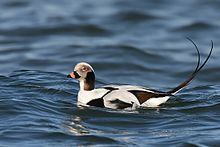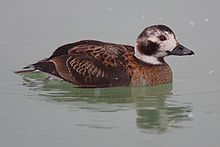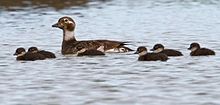- Long-tailed Duck
-
Long-tailed Duck 
Male Conservation status Scientific classification Kingdom: Animalia Phylum: Chordata Class: Aves Order: Anseriformes Family: Anatidae Subfamily: Merginae Genus: Clangula
Leach, 1819Species: C. hyemalis Binomial name Clangula hyemalis
(Linnaeus, 1758)Synonyms Genus:
Harelda
Species:
Harelda hyemalisThe Long-tailed Duck or Oldsquaw (Clangula hyemalis) is a medium-sized sea duck. It is the only living member of its genus, Clangula; this was formerly used for the goldeneyes, with the Long-tailed Duck being placed in Harelda. An undescribed congener is known from the Middle Miocene Sajóvölgyi Formation (Late Badenian, 13-12 mya) of Mátraszõlõs, Hungary (Gál et al. 1998-99).
Contents
Description
Adults have white underparts, though the rest of the plumage goes through a complex moulting process. The male has a long pointed tail (10 to 15 cm) and a dark grey bill crossed by a pink band. In winter, the male has a dark cheek patch on a mainly white head and neck, a dark breast and mostly white body. In summer, the male is dark on the head, neck and back with a white cheek patch. The female has a brown back and a relatively short pointed tail. In winter, the female's head and neck are white with a dark crown. In summer, the head is dark. Juveniles resemble adult females in autumn plumage, though with a lighter, less distinct cheek patch.
Their breeding habitat is in tundra pools and marshes, but also along sea coasts and in large mountain lakes in the North Atlantic region, Alaska, northern Canada, northern Europe and Russia. The nest is located on the ground near water; it is built using vegetation and lined with down. They are migratory and winter along the eastern and western coasts of North America, on the Great Lakes, coastal northern Europe and Asia, with stragglers to the Black Sea. The most important wintering area is the Baltic Sea, where a total of about 4.5 million gather.
The Long-tailed Duck is gregarious, forming large flocks in winter and during migration. They feed by diving for mollusks, crustaceans and some small fish. Although they usually feed close to the surface, they are capable of diving to depths of 60m (200 feet).
In North American English it is sometimes called Oldsquaw, though this name has fallen out of favour under influence of negative connotations of the word squaw in English usage. Some biologists have also feared that this name would be offensive to some Native American tribes involved in the conservation effort.[1] The American Ornithologists' Union (2000) stated that "political correctness" was not sufficient to change the name, but "to conform with English usage in other parts of the world", it officially adopted the name Long-tailed Duck.
The males are vocal and have a musical yodelling call Ow, ow, owal-ow.
The Long-tailed Duck is one of the species to which the Agreement on the Conservation of African-Eurasian Migratory Waterbirds (AEWA) applies.
References
- BirdLife International (2004). Clangula hyemalis. 2006. IUCN Red List of Threatened Species. IUCN 2006. www.iucnredlist.org. Retrieved on 11 May 2006. Database entry includes justification for why this species is of least concern
- American Ornithologists' Union (2000). Forty-second supplement to the American Ornithologists' Union Check-list of North American Birds. Auk 117:847–858.
- Gál, Erika; Hír, János; Kessler, Eugén & Kókay, József (1998–99): Középsõ-miocén õsmaradványok, a Mátraszõlõs, Rákóczi-kápolna alatti útbevágásból. I. A Mátraszõlõs 1. lelõhely [Middle Miocene fossils from the sections at the Rákóczi chapel at Mátraszőlős. Locality Mátraszõlõs I.]. Folia Historico Naturalia Musei Matraensis 23: 33-78. [Hungarian with English abstract] PDF fulltext
- Lars Svensson and Peter J. Grant. Collins Bird Guide. London: HarperCollins, 1999. p. 64.
- Chris Kightley and Steve Madge. Pocket Guide to the Birds of Britain and North-West Europe. Nr. Robertsbridge: Pica Press, 1998. p. 48.
Footnotes
- ^ Though squaw originated as a word simply meaning "young woman" in the Massachusett and related Algonquian languages, it is now considered offensive by many Native Americans and is so labelled in modern dictionaries.
External links
- Long-tailed Duck videos, photos & sounds on the Internet Bird Collection
Categories:- IUCN Red List least concern species
- Ducks
- Merginae
- Genera of birds
- Birds of Pakistan
- Birds of Iran
- Birds of Europe
- Birds of Turkey
- Birds of Greenland
- British Isles coastal fauna
- Monotypic bird genera
- Animals described in 1758
Wikimedia Foundation. 2010.



